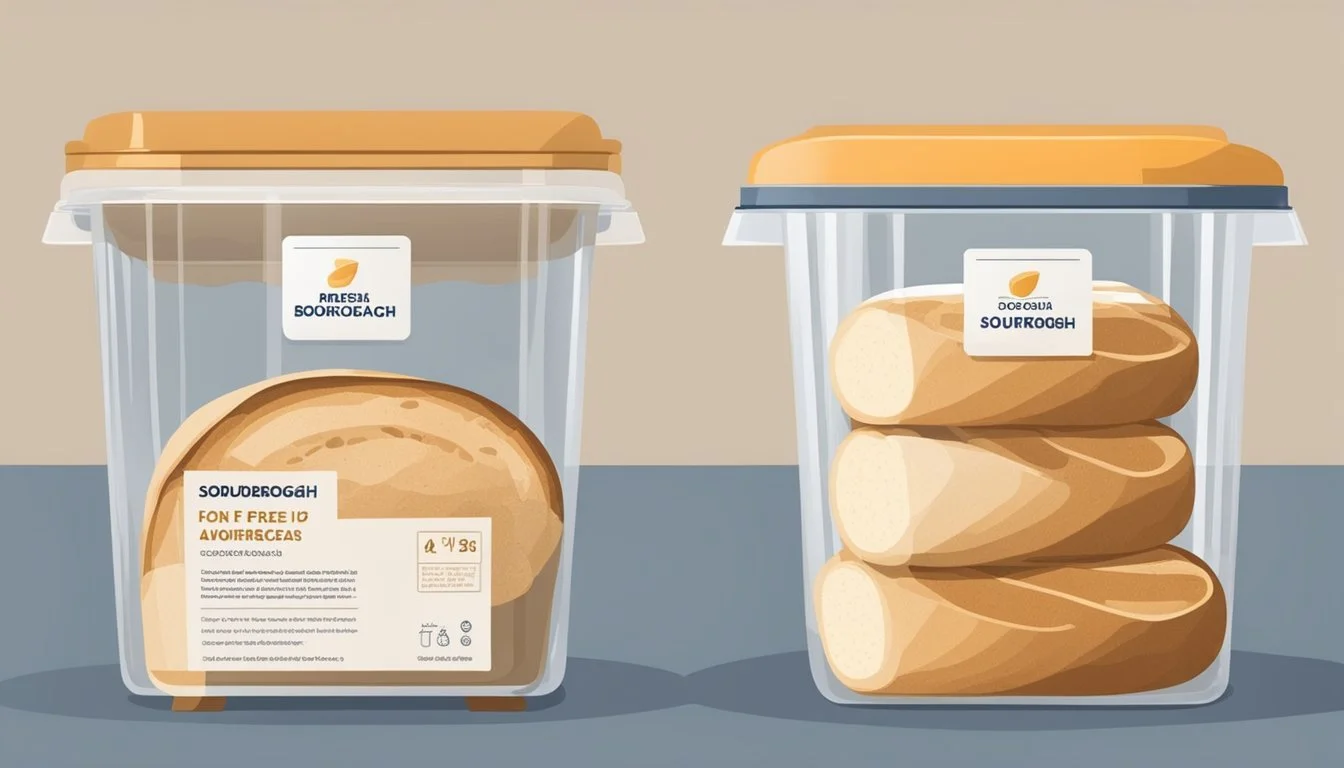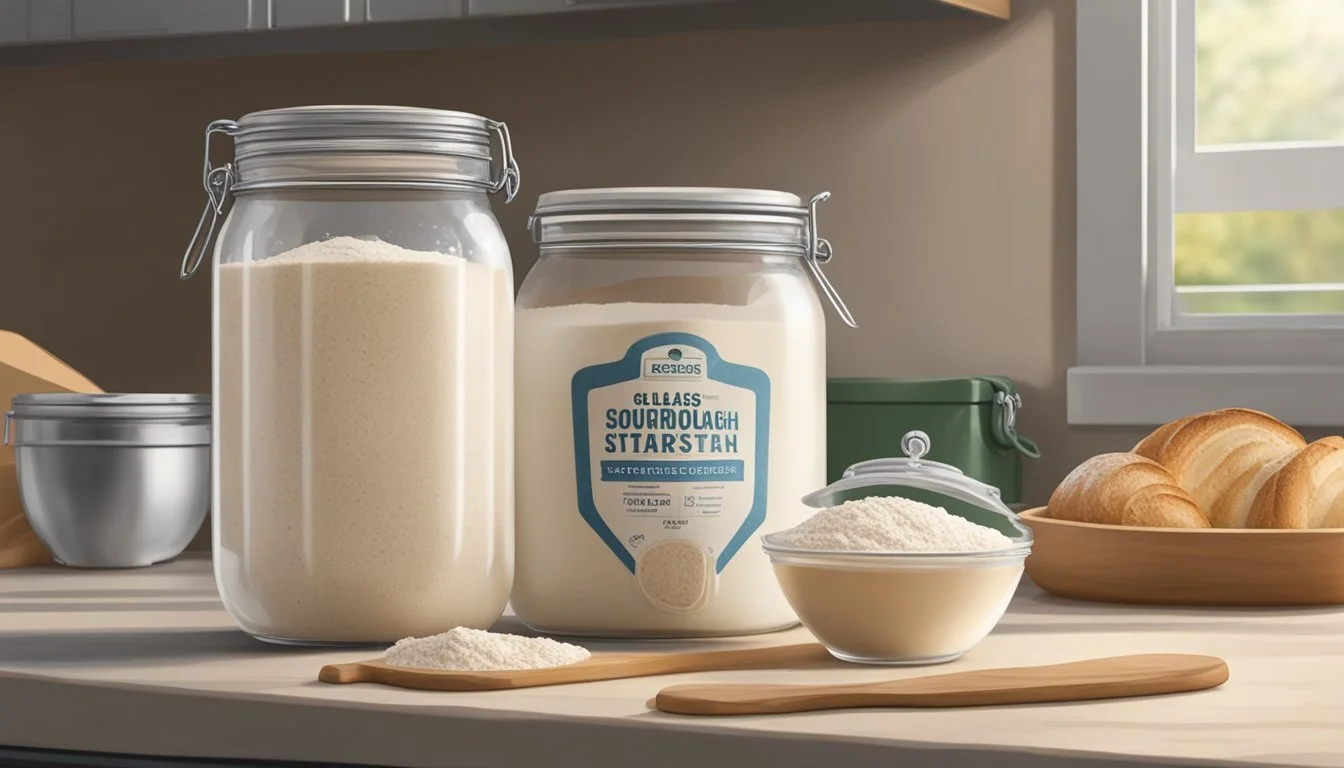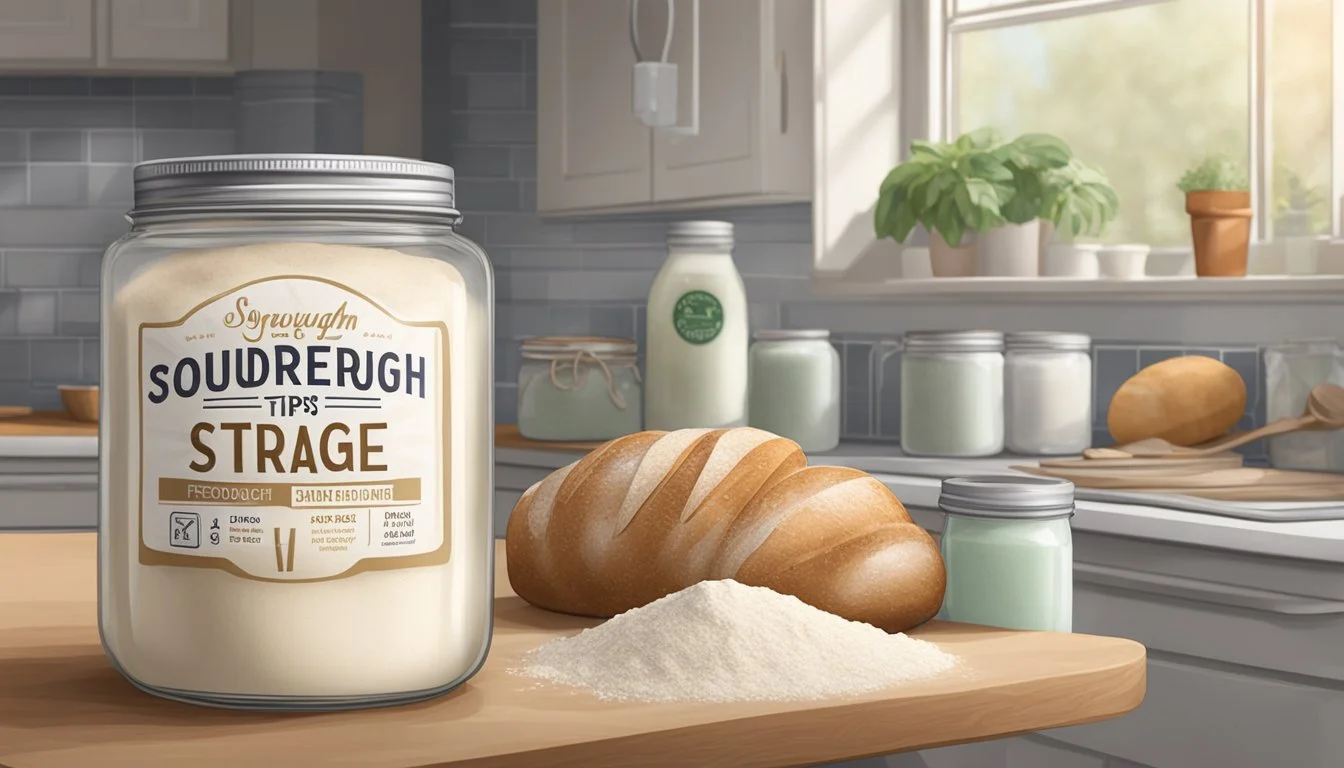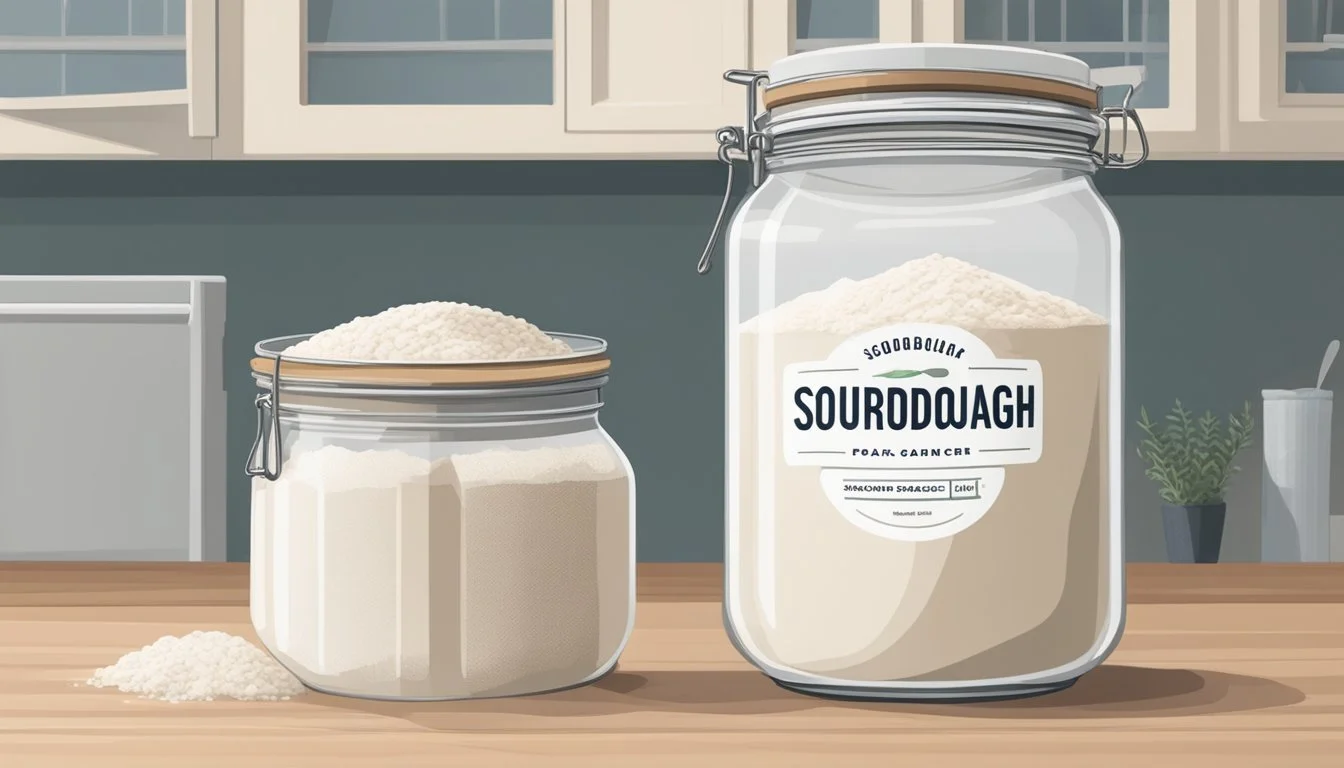Sourdough Storage and Freezing Tips for Longevity
Ensuring Freshness Over Time
Sourdough bread (What wine goes well with bread?), with its distinctive tang and artisanal quality, requires proper storage to maintain its freshness and extend its shelf life. The key to keeping sourdough fresh lies in managing temperature, airflow, and humidity. When left at room temperature, correctly stored sourdough bread can retain its quality for several days. A balance between 68-77°F (20-25°C) is ideal as fluctuations in temperature can hasten staling or encourage mold growth.
If sourdough is to be consumed within a few days of baking, it should be kept in an environment where the moisture can escape, such as a paper bag, which prevents sogginess while allowing the crust to stay crisp. When dealing with sliced sourdough, placing the cut side down against a surface reduces exposure to air, retaining its internal moisture and keeping it from drying out.
For long-term preservation, freezing sourdough bread is highly effective. Wrapping the loaf tightly in plastic wrap, aluminum foil, or placing it in a freezer bag helps maintain quality, prevents freezer burn, and locks in flavor. For thawing, simply remove the bread from the freezer and let it come to room temperature. To revitalize the loaf and recreate a freshly baked experience, one can spritz water onto its surface and warm it in an oven preheated to 350°F (175°C), which helps restore the crust’s crunch and the bread's warm, inviting aroma.
Understanding Sourdough Characteristics
Sourdough bread distinguishes itself from other breads through its unique preparation and fermentation process. It begins with a sourdough starter, a mixture of flour and water that harnesses wild yeast and lactobacilli from the environment. Over time, this starter ferments, developing the bread's distinctive tangy flavor and altering its texture.
The fermentation process is both an art and a science. As the starter matures, it fosters a rich, complex flavor not found in breads made with commercial yeast. The flavor of sourdough is often described as tangy due to lactic acid produced during fermentation.
Characteristic Description Fermentation Sourdough bread's fermentation is slower compared to yeast breads, resulting in its unique qualities. Flavor Lactic and acetic acids give sourdough its characteristic tangy taste. Texture The interaction between enzymes and the gluten network in the dough leads to a chewy texture and airy crumb. Starter Resilience A well-maintained starter can last indefinitely, being "fed" with a routine addition of flour and water.
When considering the bread's texture, sourdough enthusiasts appreciate the crusty exterior paired with a soft, chewy interior. The bread's consistency is also a direct result of the fermentation time it spends rising.
In summary, sourdough's signature characteristics—flavor, texture, and fermentation—are the product of its starter, a testament to the timeless techniques of bread making. Understanding these qualities helps bread lovers and bakers alike to better appreciate and handle sourdough.
Optimal Sourdough Storage Conditions
Storing sourdough bread efficiently ensures its freshness, taste, and texture are maintained. Factors such as humidity, temperature, and the right choice of storage can significantly influence the shelf life of sourdough bread.
Indoor Humidity and Temperature
An ideal room temperature for storing sourdough bread ranges between 68-77°F (20-25°C). Humidity levels should be moderate as high moisture can lead to mold growth, while low humidity can cause the bread to dry out.
Choosing the Right Storage Containers
Store sourdough in linen or cotton bread bags, beeswax wrap, or a bread box to balance moisture retention and air circulation. Plastic bags may be used for short-term storage, but can lead to moisture buildup that promotes mold.
Preventing Moisture and Mold
Using breathable materials like a linen bag or a paper bag helps to prevent unwanted moisture and mold growth. Avoid airtight containers which can trap moisture and result in quicker spoiling.
Shielding from Light and Air
Minimize exposure to air and direct sunlight to decrease the rate of staling. Wrap sourdough loosely in aluminum foil or place it inside a bread box to protect it from light and excess air.
Short-Term Versus Long-Term Storage
Short-term storage: Room temperature is suitable for a couple of days.
Long-term storage: Freezing extends shelf life while preserving quality.
Sourdough Bread at Room Temperature
For daily use, keep sourdough bread on the counter, ideally in a bread box or wrapped in a cloth bag to strike a balance between maintaining freshness and preventing drying out.
Refrigerating Sourdough Bread
Refrigeration is typically not recommended as it accelerates staling due to the crystallization of starches in the bread. Yeast activity is also slowed down, which can affect texture and flavor.
Freezing and Thawing Sourdough
Freezing sourdough bread is effective for long-term preservation. To freeze, slice before wrapping in plastic wrap or aluminum foil, then place in a freezer bag. To thaw, let the bread come up to room temperature or refresh in the oven at 350°F for a crisp crust. Avoid freezer burn by ensuring the bread is wrapped tightly with minimal air exposure.
Proper Slicing and Packaging
When preserving sourdough bread for extended periods, how one slices and packages it is crucial. Slicing should be done on a sturdy cutting board using a sharp bread knife. The thickness of the slices depends on personal preference, but consistently sized slices will freeze and thaw more evenly.
For sliced sourdough, it is beneficial to interleave parchment paper between the slices before packaging. This prevents them from sticking together and allows one to remove a single slice easily without having to thaw the entire loaf.
Regarding packaging, sourdough must be protected from the freezer's dry environment to prevent freezer burn and maintain quality. Wrapping individual slices or a whole loaf tightly in plastic wrap is the first step. Then, placing the wrapped bread in a ziploc bag or a freezer-safe bag or container is essential. One should ensure to remove as much air as possible before sealing to prevent ice crystals from forming.
Steps for slicing and packaging sourdough:
Slice on a cutting board with a sharp knife.
Interleave slices with parchment paper (optional for sliced sourdough).
Wrap tightly in plastic wrap.
Place in a ziploc bag or freezer-safe container.
Remove excess air and seal firmly.
For those with leftover sourdough that has dried out, these can be processed into bread crumbs before storage. Simply pulse the dried pieces in a food processor, package similarly in an air-tight container, and freeze for future use. This method efficiently manages bread waste and provides a useful cooking ingredient.
Maintaining Freshness after Freezing
When it comes to sourdough bread, freezing is a viable option for extending its shelf life without significant loss of quality. To ensure the crust retains its crispness and the texture remains pleasing, one must adhere to proper thawing and rejuvenation methods.
Thawing Sourdough Bread:
Remove the bread from the freezer and allow it to thaw naturally at room temperature.
For sliced bread, separate the slices to ensure even thawing.
Preheat your oven to 350°F (175°C).
Before placing bread in the oven, lightly dampen the crust with cold water.
Heat the frozen bread for approximately 5-6 minutes. The water will evaporate, and the crust should crisp up, reminiscent of freshly baked bread.
To counteract the staling process and prevent staleness, it’s crucial to wrap the bread tightly before freezing. This minimizes exposure to air and moisture, which can compromise the quality of the bread.
Storing Thawed Bread:
Post-thawing, store the bread in a paper bag or bread box at room temperature.
Consume within 2-3 days to enjoy optimal freshness.
Using these methods can help one enjoy homemade bread that tastes fresh and maintains its desired characteristics. While freezing can inevitably change the qualities of fresh bread to some extent, proper storage and revitalizing techniques can preserve its texture and flavor.
Maximizing Shelf Life
Storing sourdough bread properly extends its shelf life, maintaining freshness and preventing waste. Bread storage is crucial, and there are several methods to consider.
Before Storing:
Cool Before Storing: Always allow the sourdough to cool completely after baking. Storing while still warm can result in condensation and mold growth.
At Room Temperature:
Beeswax Wrap: Instead of using plastic wrap, one can opt for a beeswax wrap, allowing the bread to breathe while maintaining moisture.
Bread Boxes: Bread boxes offer an ideal environment, balancing humidity and airflow, which are key to longevity.
Table: Room Temperature Storage Methods
Storage Method Pros Cons Beeswax Wrap Breathable, sustainable May not seal as tightly as plastic Bread Box Balances humidity and airflow Occupies counter space Paper Bag Allows bread to breathe, prevents sogginess Less durable, not airtight
For Extended Storage:
Freezing: For long-term preservation, freezing sourdough is effective. Wrap bread tightly in a preservative manner before freezing to ward off freezer burn and staling.
Slicing Before Freezing: Sliced bread can be frozen and thawed piece by piece, offering convenience and reducing waste. Thaw at room temperature.
When storing bread, be mindful not to squash it, as this diminishes its texture. By following these techniques, one ensures the longevity of sourdough without compromising its taste or quality.
Baking and Refreshing Tips
When one bakes sourdough bread, achieving the perfect crust and crumb is paramount. It is advisable to preheat the oven to the recommended temperature, often around 350°F (175°C), ensuring even baking throughout the loaf. Homemade sourdough bread benefits from the heat circulation provided by a baking stone or cast iron pan, creating a professional-quality crust.
For those opting to use a toaster to refresh sourdough slices, care should be taken not to over-toast, as sourdough can quickly become overly crisp. A medium setting generally suffices to rejuvenate the bread's texture and warmth without sacrificing moisture.
Regarding refreshing frozen sourdough, it is best practiced by thawing the bread at room temperature. If the sourdough was pre-sliced before freezing, separating the slices prior to thawing ensures an even return to the bread's original texture.
Method Temperature Setting Tips Oven Baking 350°F (175°C) Use a baking stone or dutch oven for best results. Toaster Refresh Medium Briefly toast to revive slices without drying them out. Thawing Room Temperature Allow frozen bread to thaw completely before serving or toasting.
To improve oven refreshment of stale or frozen bread, lightly moisten the surface with water. Place it directly on the oven rack or a preheated baking stone to foster a crisp exterior. A few minutes is usually sufficient for the loaf to regain its freshness. It should be highlighted that sourdough's dense structure responds well to this method, making it an ideal bread for freezing and subsequent refreshment.
Creative Uses for Stale or Dry Sourdough
Transforming stale sourdough into culinary delights is not only a confident step against food waste, but it also provides an opportunity to explore versatile and delicious recipes.
Sourdough Croutons are an ideal choice for repurposing dry bread. One can simply dice the bread, toss it with olive oil, and season with salt and pepper before baking in the oven at 350°F (175C) until golden and crispy. These croutons can add a satisfying crunch to soups and salads.
Breadcrumbs made from stale sourdough bread adds depth to various dishes. The bread can be pulverized into fine crumbs in a food processor, then used for coating proteins, topping casseroles, or even as a binder for meatballs.
Savoury Bread Pudding becomes an enticing option for stale bread as it absorbs flavors well. Incorporating vegetables, cheese, and eggs, the bread can be rebaked into a comforting dish.
Use Method Additional Notes Panzanella Salad Tear sourdough into chunks and mix with fresh tomatoes, cucumbers, and vinaigrette. Revitalize dry bread with the moisture from vegetables and dressing. French Toast Soak the bread in a mixture of beaten eggs, milk, cinnamon, and sugar, then pan-fry until golden. Stale bread holds up better, preventing sogginess.
Last, but not least, stale bread can be turned into a base for stuffing, where it's mixed with herbs and stock to accompany roasted meats (What wine goes well with roasted meats?).
These ideas aim to inspire the utilization of stale sourdough in ways that maintain its value, give a second life to seemingly dry loaves, and bring a touch of creativity into everyday cooking.
Labeling and Tracking Sourdough Inventory
Proper labeling and dating are critical components of inventory management for sourdough bread and starter to ensure longevity and quality. When freezing or storing sourdough products, one should follow these clear, systematic steps to maintain an organized inventory:
Labeling: Each sourdough item, whether it's a loaf, sliced bread, or dough, must be labeled clearly. The label should include the product type and the date of storage.
Item Label Details Whole Loaf Type, Freeze Date Sliced Bread Type, Freeze Date Sourdough Dough Type, Freeze Date
Dating: Write the storage date on the label to track how long the bread or starter has been stored. This information helps in using older inventory first and maintains the product’s freshness.
Storage Records: Keep a log or spreadsheet to record details of the sourdough inventory:
Date Added Product Type Quantity Expected Shelf Life 2024-03-15 Whole Sourdough Loaf 5 Loaves 3 Months 2024-03-16 Sourdough Starter 1 Jar Indefinite
Review and Rotate: Regularly review the stored inventory. Rotate the stock by using the first-in-first-out method (FIFO), which promotes using the oldest items first and adding new items to the back of the storage space.
These steps ensure that each sourdough product is accounted for and can be easily located, minimizing waste and maximizing the use of the bread and starter. Tracking the sourdough inventory with precision upholds the quality and flavor that sourdough connoisseurs appreciate.
Frequently Asked Questions (FAQ)
Before diving into the specifics of sourdough bread storage and freezing, it’s essential to understand that proper techniques can significantly extend the bread's freshness and taste. This FAQ section addresses common concerns and offers clear solutions.
Can Sourdough Bread Be Stored in a Bread Box?
Yes, a bread box can be an ideal environment for storing sourdough bread as it balances humidity and airflow, which are crucial to maintaining the bread's quality. Bread boxes can keep sourdough fresh for several days.
How Long Does Homemade Sourdough Last?
Homemade sourdough bread typically maintains its quality for about 3-4 days at room temperature if stored properly. Keeping it in a paper bag, such as a brown paper bag or parchment paper, can extend its shelf life by letting moisture escape while protecting it from excess air.
What Is the Best Way to Thaw Frozen Sourdough?
To thaw frozen sourdough bread, you should place it in the refrigerator overnight or let it sit on the countertop. Once thawed, you can heat it in an oven preheated at 176°C/350°F for a few minutes to rejuvenate its crisp crust.
Are Plastic Bags Safe for Storing Sourdough?
Storing sourdough in a plastic bag is safe and can prevent it from drying out too quickly. However, a plastic bag may not be ideal for long-term storage as it could promote mold growth due to trapped moisture. To minimize this, ensure that the bread is completely cool before sealing it in.
Is It Better to Freeze Sourdough Sliced or Whole?
Whether to freeze sourdough bread sliced or whole depends on your consumption habits:
Sliced: Freezing in slices provides the convenience of thawing only what you need.
Whole: If you anticipate consuming the entire loaf shortly after thawing, freezing it whole can preserve the bread's interior moisture better.
For both methods, use freezer-safe bags or containers and wrap the bread tightly to protect against freezer burn and maintain its quality.
Conclusion
Storing sourdough bread properly ensures its freshness and longevity. The ideal method depends on when one intends to consume the bread. For short-term storage, room temperature is suitable, ensuring the bread is kept in a cool, dry place, between 68-77°F (20-25°C), and away from direct sunlight. The bread should be wrapped in a cloth or placed in a bread box to minimize air exposure while allowing for slight airflow, preventing staleness and mold growth.
Freezing is the strategy for long-term preservation. Before freezing homemade sourdough bread, it's advisable to slice it for convenience. Each slice or the whole loaf should be stored in a freezer-safe bag or container, tightly sealed to protect against freezer burn and moisture loss. Here's a simple guide to follow:
Slice (optional): Slice the sourdough for individual servings.
Wrap: Utilize plastic wrap, aluminum foil, or a reusable freezer bag.
Label: Mark the package with the date of freezing.
Freeze: Place it in the freezer, ensuring it's flat and away from any items that might crush it.
When ready to eat, one should thaw the bread at room temperature. If the bread was frozen in slices, separate them before thawing. To restore the fresh-bread taste and crispness of homemade sourdough bread, one might opt to briefly reheat it in an oven preheated to 350°F (175°C).
By following these suggestions, the integrity of sourdough's distinct texture and flavor can be maintained, whether enjoying a slice from a freshly-baked loaf or savoring it weeks later.






